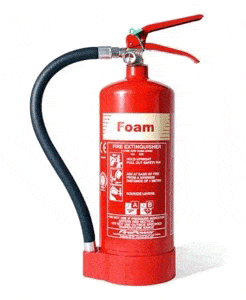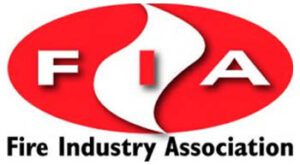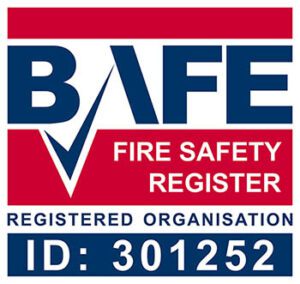Foam extinguishers are one of the most common fire extinguisher types. They are generally used for fires involving flammable solids and liquids and so are suitable for the majority of businesses.
Read more about types of fire extinguishers:
- Water fire extinguisher
- Dry powder fire extinguisher
- CO2 fire extinguisher
- Wet chemical fire extinguisher

Also known as:
• AFFF foam fire extinguishers
• AFFF fire extinguishers
• Spray foam fire extinguishers
How to identify a foam fire extinguisher:
• CREAM coloured label printed on the body stating ‘Foam’• Should be identified by an extinguisher ID sign fixed nearby – ‘Foam Extinguisher’
Sizes of foam fire extinguisher available:
• 2 litre
• 3 litre
• 6 litre (most commonly used)
• 9 litre
What is a foam fire extinguisher used for?
Foam fire extinguisher uses:• Fires involving flammable solids, such as paper, wood, and textiles (‘class A’ fires)
• Fires involving some flammable liquids, such as petrol, diesel, and paint (‘class B’ fires)
• Fires involving electrical appliances IF the extinguisher has passed the 35kv conductivity test
Please note: foam extinguishers are not explicitly designed for use on electrical fires.
The 35kv conductivity test is an additional safety measure intended to safeguard users who accidentally use a foam fire extinguisher on an electrical fire – there is a risk to using a foam fire extinguisher this way, including the possibility of getting an electric shock.
We strongly recommend ONLY using a CO2 extinguisher or a Dry Powder extinguisher for electrical fire risk.
Read more about the different types of fire extinguisher.
Learn what the different extinguisher colours signify.
Do not use foam fire extinguishers for:
• Cooking fires involving oil and grease, such as chip pan fires (‘class F’ fires)• Fires involving flammable gases, like methane and butane (‘class C’ fires)
How do foam extinguishers work?
Foam fire extinguishers work in 2 ways.
Firstly, they are mainly water-based and so have the same cooling effect as water extinguishers, putting the fire out by lowering the temperature.
Secondly, they contain ‘Aqueous Film Forming Foam’ (this is why they are also known as AFFF foam extinguishers).
AFFF works by smothering the fire and sealing in the flammable vapours. This prevents the fire re-igniting. It also allows foam fire extinguishers to put out flammable liquid fires, by creating a barrier between the liquid’s surface and the flames.
Pros and Cons of foam fire extinguishers:
Pros: non-toxic, non-damaging to most materials, largely safe if accidentally used on electrical fires (although this is not recommended), designed to prevent the re-ignition fires, lighter in weight than the equivalent water extinguisher.
Cons: damaging to electrical appliances. Dangerous if used on cooking fires or flammable gas fires.
Who needs foam fire extinguishers?:
Foam fire extinguishers are the ideal extinguishers for premises with multiple fire risks, such as:
• Offices
• Warehouses
• Factories
• Garages
• Hotels
In fact, most premises benefit from having foam extinguishers and these are frequently recommended, especially when paired with CO2 extinguishers for use on electrical fires.
How to use a foam extinguisher:
Foam fire extinguishers need to be used differently, depending on the type of fire.
In all cases, firstly remove the safety pin – this will break the anti-tamper seal – and stand well back from the fire.
Flammable liquids fires:
• Do NOT spray directly at the fire, this can cause it to spread to nearby surfaces• Where the liquid on fire is contained, point the extinguisher at the inside edge of the container
• If it’s not contained, spray with a gentle, sweeping movement across the TOP of the fire, or against an adjacent surface
• This way the foam will drop down and settle on the top of the burning liquid
Flammable solids fires:
• Aim at the base of the fire• Keep the extinguisher moving forwards and backwards across the flames as you spray
Electrical fires (not recommended):
• Treat the same way as flammable solids fires• Stand at least 1m away from the flames to minimise the risk of electric shocks
If you think you need foam fire extinguishers, or if you’re not exactly sure what you need, just get in touch with our friendly team by calling 0800 157 1113 or emailing [email protected].
They can arrange a free survey visit for you from a BAFE registered engineer.
All extinguishers we supply come with a 5 year guarantee, and we will fit and commission them for you, free of charge.
Why buying with Surrey Fire is your best decision yet
When you buy foam fire extinguishers from us, we’ll give you a 5-year guarantee. And that’s not all. We’ll also deliver, fit, and commission them – 100% Free of Charge.
Most of our clients buy foam fire extinguishers from us. As mentioned, they are good, general-use extinguishers, suitable for most premises, and tackle flammable liquid and flammable solid fires.
You may have known what they are used for, but did you know that, when you buy foam fire extinguishers on the internet, they must STILL be commissioned by a professional?
In other words, you could end up spending more when you were trying to spend less.
When you buy foam fire extinguishers from us, you don’t need to worry about this kind of unexpected cost.
We give all of our clients a completely FREE, end-to-end service when they buy foam fire extinguishers, making sure they are compliant with current extinguisher regulations and insurance requirements.
(Find out about UK fire extinguisher regulations here.)
We’re confident you’ll find buying foam fire extinguishers from us affordable, simple, and quick, regardless of the type or size of your business.
Call 0800 157 1113 to buy foam fire extinguishers or to book a FREE SURVEY visit from one of our friendly engineers.
We only buy foam fire extinguishers which are kitemarked and meet both British and European standards. And if you need any others, well of course we carry the full range of fire industry-approved extinguishers.
As we said, we’ll also give you a 5-year guarantee on every foam fire extinguisher you buy.
All of our fire extinguisher engineers are approved by BAFE, a 3rd party industry body. If you’re not sure exactly what you need, then they will happily carry out a no-obligation, free survey.
Why Surrey Fire is your best bet:
- Competitive prices and fast, friendly service
- We deliver, fit & commission Free of Charge – just pay for the extinguishers you need
- We guarantee all of our foam extinguishers for 5 years
- All of our foam extinguishers are Kitemarked, meeting British Standards
- BAFE registered extinguisher engineers
- No obligation Free Survey and friendly advice
- Next day delivery available
For a quote to buy foam fire extinguishers or to arrange a free survey visit, contact our friendly team by email: [email protected], or by phone: 0800 157 1113. We’ll be happy to help.
Contact Us


